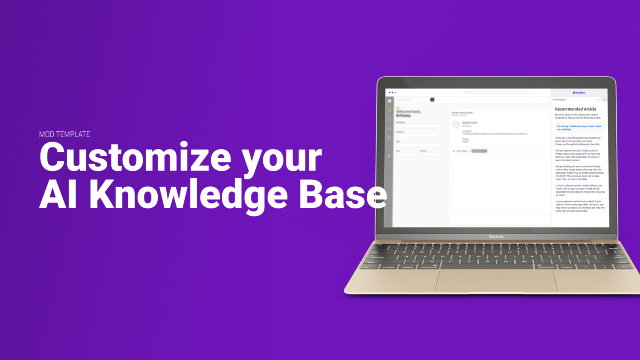Google Translate is popular because it’s easy to use, completely free, and everyone’s already had...
How AI Is Transforming the Call Center (And How To Get Ahead of This Trend)
When you manage a call center, it feels like you need all the help you can get. Between high turnover rates, irate customers, and ever-shrinking resources, it can be tough to actually hit your metrics. So, understandably, you might have been looking to AI tools like ChatGPT, wondering if they’d be any help.
Well, you’re not alone. Not only are AI tools already making a splash in call centers like yours, but that impact is being actively studied, meaning there’s actual data out there that’ll help you make a decision. Let’s dive in.
Interested in building your own Knowledge Base Recommender? Try out this template.

AI’s old place in the call center
If you’ve called a customer support line at any point in the past few years, you’ve probably already encountered AI. Gone are the days when a human being would direct your call to the right extension, and even the venerable “press 1 to reach customer support” menus are outdated. For years now, many call centers have been using natural-language-processing AI solutions to direct calls, which ask customers to speak their request out loud before being dispatched to the right department.
But while AI has had a place in dispatching and triaging requests for years, it still hasn’t done all that much to help call center agents get their own work done.
Until now.
How AI is transforming call centers
ChatGPT — and other generative AI solutions — made huge waves when first shared with the public back in November of 2022. Since then, individual users and organizations alike have been experimenting with it in tons of ways, from writing and reviewing code to running entire businesses. So what about call centers? Well, thanks to a recent paper from Stanford and MIT academics that explores generative AI use among customer support agents, we can get a pretty good idea of how AI is already changing the game for call centers.
The paper covered AI use among more than 5,000 customer support agents. Agents were given access to a generative AI tool that took in requests from customers — much like ChatGPT takes in a prompt — and dynamically wrote responses that agents could integrate into their replies. That means the platform is a bit more specialized than a tool like ChatGPT, but this paper can still give some great insights into how any AI tool can help your call center agents.
Generative AI helps people work faster
One of the most important findings in this paper? Agents were 14% more productive when they used AI. “More productive” means that agents were resolving more customer issues per hour with AI than without. This is great news for customer support leaders, who are always trying to find new ways to improve productivity across their teams.
AI closes the skill gap
Most tools work best in the hands of the most skilled operators. But that doesn’t seem to be the case for AI. The paper classed the customer support agents into five groups, from the highest-skilled to the least-skilled. The agents in that bottom group saw a 35% increase in issue resolutions per hour while the most skilled had little to gain from AI. Moreover, new agents (with less than a month of experience) saw a similar improvement in their performance — while the most experienced saw little impact on their work.
What does that mean for customer support leaders? You can essentially use AI to speed-run the onboarding of new agents, which is incredibly valuable in an industry with such a high turnover rate.
Using AI leaves more customers satisfied
How many times a day does a customer support agent hear the phrase “I want to talk to your manager?” Often, it can feel like there’s nothing an agent can do to prevent a difficult caller from requesting a manager’s attention, and getting too many of these requests can slow your call center’s operations to a crawl. So how did AI perform here?
It reduced the number of requests for a manager by nearly 25%.
Not only can AI make new agents perform like they’ve been working with you for years, but your customers can also feel the difference.
So, in summary, here’s how AI is changing the game for the call center:
- Customer agents resolve more issues.
- New agents work more efficiently.
- It closes the skill gap between your high-performers and their coworkers.
- Fewer customers want to talk to a manager.
How to get ahead of this trend with PixieBrix
Now that you know how AI is changing the game for call centers, it’s time to roll it out for your teams. But how do you go about it? Do you just bookmark ChatGPT in everyone’s browser? Or do you add a dedicated AI solution to your budget for next year?
Here’s the best way to get ahead of the AI trend right now: PixieBrix.
PixieBrix is a low-code platform that’ll let you plug AI tools — like ChatGPT — into the websites and software tools your teams need to get things done. You can build your own Chrome extensions or use the pre-built mods on the PixieBrix Marketplace to deploy AI-powered extensions in minutes. Curious about what you can do with these mods? Here are just a few of them:
Knowledge Base Copilot: You could have the most detailed knowledge base in the world, but it won’t do your team much good if they can’t find anything in it. Call center agents naturally try to find the quickest, easiest way to get things done while they’re on a call, and your knowledge base should support that. This PixieBrix mod will whip your knowledge base into shape.
Write Assist: Introducing your very own writing assistant, available on Chrome for convenient access wherever you write! Write for your target audience, check your text against brand guidelines, quickly shorten text and check for typos.
AI Copilot: One of the inescapable realities of the call center? The same problems will come up again and again. Even if your team is getting used to having AI by their side, they might still be losing a bunch of time repeatedly typing in the same prompts. With the AI Copilot from PixieBrix, you can access your most used prompts from any webpage.


